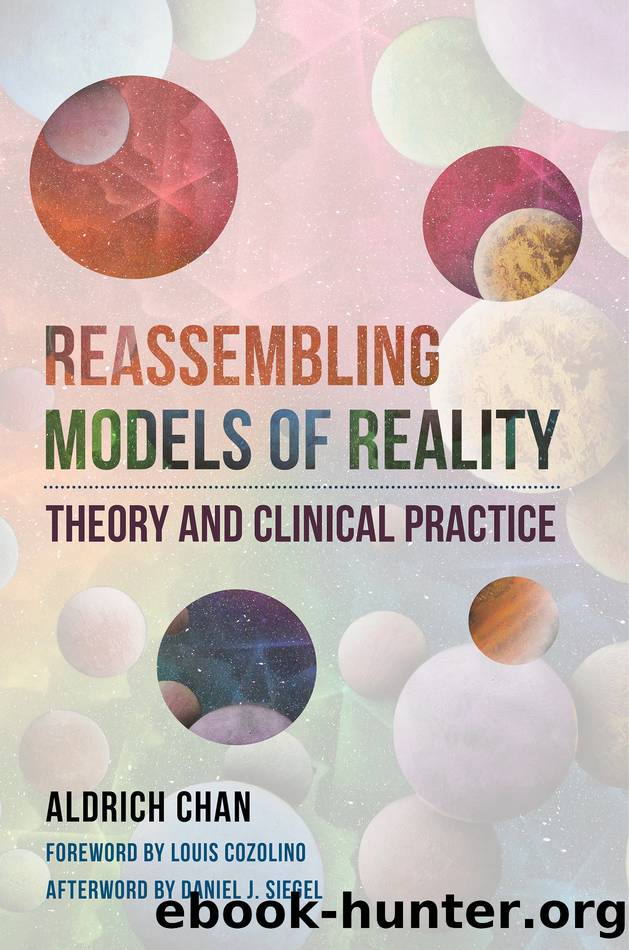Reassembling Models of Reality: Theory and Clinical Practice by Aldrich Chan

Author:Aldrich Chan [Chan, Aldrich]
Language: eng
Format: epub
Tags: Psychology, Clinical Psychology, Interpersonal Relations, Cognitive Neuroscience & Cognitive Neuropsychology
ISBN: 9781324015987
Google: Pi_xDwAAQBAJ
Publisher: W. W. Norton & Company
Published: 2021-04-13T00:00:29.917523+00:00
APPLICATIONS: SELF-CONTROL AND THE QUEST FOR MEANING
Withdraw into yourself and look. And if you do not find yourself beautiful yet, act as does the creator of a statue that is to be made beautiful . . . cut away all that is excessive, straighten all that is crooked, bring light to all that is overcast, labour to make all one glow of beauty and never cease chiseling your statue.
âPLOTINUS
Meaning is a product of relationships, and relationships are founded on meaning. In isolation, subjects and objects cease to be, and are rendered meaningless. One requires the other to exist. Meaning is thus a result of relationships between polarities. As has been explored, meaning may be conceptualized and expressed in different ways. Sartre endorses the notion that meaning is created, Frankl that meaning is discovered and derived from the moment, and Hayes suggests that meaning is a process of living a life according to values you consciously decide. Experiential truth is found through the experimentation of different systems, which is for every individual to experience themselves.
Underlying the ability to pursue any conscious direction is self-control (Baumeister & Exline, 2000). Self-control is governed by our capacity to inhibit, which when done successfully develops descending inhibitory tracts. For this reason, I speculate that internal conflicting stimuli may serve the secondary purpose of exercising our ability to inhibit, which may expand our metacognitive capacities. In other words, continued desires need not be seen as a nuisance or evolutionary mistake, but instead as an opportunity to advance our neural development, enabling improved chances for conscious living and the evolution of meaning. To make it clear, every time we inhibit a maladaptive impulse, we assert our freedom by establishing dominance. Importantly, we are not negating the existence of these impulses; rather, we seek to redirect our impulsesâ purpose toward an integrated response in service of a higher meaning that benefits the entire organism.
With constant reinforcement, pleasurable responses may become automated and eventually habitual. Unfortunately, every time we engage in habitual cycles, we reinforce their existence in our neural pathways, strengthening their connections to a system of the brain associated with regulating our behaviors as a result of pleasure (i.e., the reward center). Sometimes, these habits are not conducive to our long-term goals, in which case we will need to develop appropriate practices to redirect their paths. In a way, we can be like bulls in a bullfighting ring. We are first released into life, and we begin charging at red veils being held by performers. The veils represent lifeâs promises of some lasting satisfaction, with the performers being the instigators. Most of the time, as soon as we hit the mark, we miss it, or we realize there is another veil waiting for us. Other times, we manage to hit the target and find temporary freedom, only to find there are more waiting for us. It is a cruel game, and eventually life takes us.
The core foundations of self-control stretch back to successful ascetic practices that lead to positive transformation and virtuous behavior (Graiver, 2018).
Download
This site does not store any files on its server. We only index and link to content provided by other sites. Please contact the content providers to delete copyright contents if any and email us, we'll remove relevant links or contents immediately.
| Administration & Medicine Economics | Allied Health Professions |
| Basic Sciences | Dentistry |
| History | Medical Informatics |
| Medicine | Nursing |
| Pharmacology | Psychology |
| Research | Veterinary Medicine |
Machine Learning at Scale with H2O by Gregory Keys | David Whiting(4255)
Fairy Tale by Stephen King(3300)
Will by Will Smith(2862)
Hooked: A Dark, Contemporary Romance (Never After Series) by Emily McIntire(2526)
Rationality by Steven Pinker(2321)
Friends, Lovers, and the Big Terrible Thing by Matthew Perry(2174)
The Becoming by Nora Roberts(2141)
Love on the Brain by Ali Hazelwood(2012)
The Strength In Our Scars by Bianca Sparacino(1815)
HBR's 10 Must Reads 2022 by Harvard Business Review(1815)
A Short History of War by Jeremy Black(1811)
Leviathan Falls (The Expanse Book 9) by James S. A. Corey(1689)
A Game of Thrones (The Illustrated Edition) by George R. R. Martin(1653)
515945210 by Unknown(1639)
Bewilderment by Richard Powers(1572)
443319537 by Unknown(1518)
The 1619 Project by Unknown(1434)
The Real Anthony Fauci: Bill Gates, Big Pharma, and the Global War on Democracy and Public Health (Childrenâs Health Defense) by Robert F. Kennedy(1382)
Works by Richard Wright(1310)
